Introduction to Vanilla Paste
Vanilla paste is a flavorful ingredient cherished by home cooks and professional bakers alike. It combines the convenience of extract with the rich flavor of vanilla beans. Unlike extracts, vanilla paste contains visible seeds, making it ideal for recipes that need a bold flavor and visual appeal. It’s thicker than extract, often sweetened, and offers a perfect balance of aroma and taste. Therefore, many prefer it for its versatility in both baking and savory dishes. With its concentrated form, you only need a small amount for a powerful flavor boost. Let’s explore the best vanilla paste recipe for 2025.
Table of Contents
Ingredients for the Best Vanilla Paste
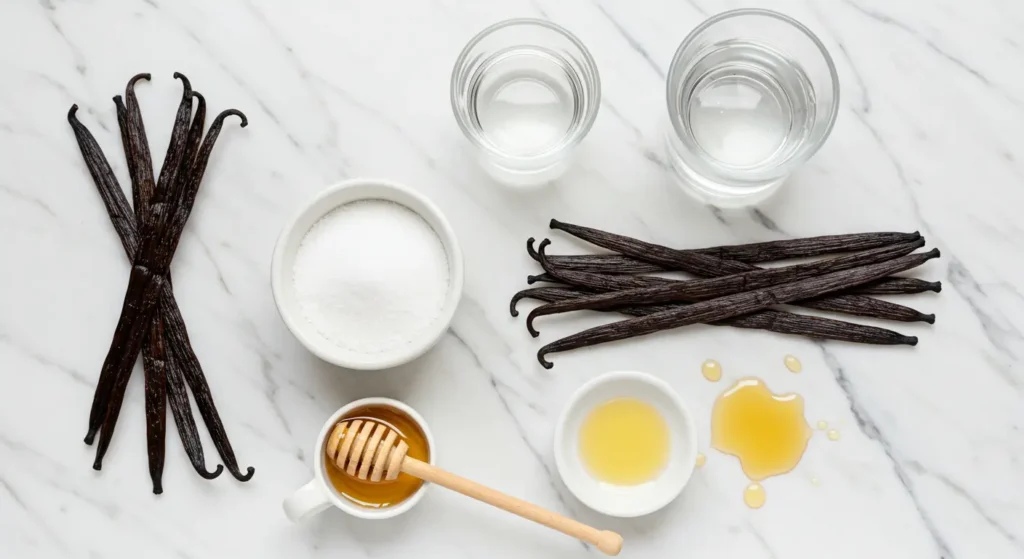
Creating the best vanilla paste recipe for 2025 requires simple yet high-quality ingredients. By choosing the right items, you can achieve a rich, aromatic, and versatile paste that enhances any dish. Here is a compilation of the key ingredients required:
- Vanilla beans: 10 to 12 high-quality, plump beans (preferably Madagascar, Tahitian, or Mexican) for deep flavor and aroma.
- Sugar or sweetener: 1/2 cup granulated sugar, brown sugar, or a natural sweetener like maple syrup for balance and sweetness.
- Vegetable glycerin: 1/4 cup to create a smooth and thick consistency while preserving freshness.
- Water: 1/4 cup to help blend the ingredients evenly.
- Optional honey: 1 tablespoon to add natural sweetness and an extra layer of flavor.
When gathering these ingredients, make sure the vanilla beans are fresh and pliable, not dry or brittle. Moreover, using high-quality glycerin and sweeteners ensures a smoother, richer result. With these items on hand, you’re ready to prepare a vanilla paste that stands out for its flavor and texture. Let’s move to the next steps and bring this best vanilla paste recipe for 2025 to life!
Tools and Equipment
To create the best vanilla paste recipe for 2025, having the right tools and equipment is essential. These items ensure the process is smooth and the paste achieves the perfect consistency. Here is a list of the necessary tools you will need:
- Sharp knife: This is used to split and scrape the vanilla beans effectively.
- Cutting board: A sturdy surface to prepare the beans without mess.
- Blender or food processor: Essential for mixing the ingredients into a uniform paste.
- Mixing bowl: For combining the ingredients before blending.
- Rubber spatula: To scrape down the sides of the blender to avoid waste.
- Measuring cups and spoons: For precise measurements of the sweetener, glycerin, and water.
- Airtight jar or container: To store the finished vanilla paste and preserve its freshness.
- Small funnel (optional): To transfer the paste into the storage jar without spills.
Each tool has a specific purpose, and using them makes the process more efficient. As a result, you can confidently proceed to prepare your paste. Next, we’ll dive into the method for crafting the best vanilla paste recipe for 2025.
Step-by-Step Guide
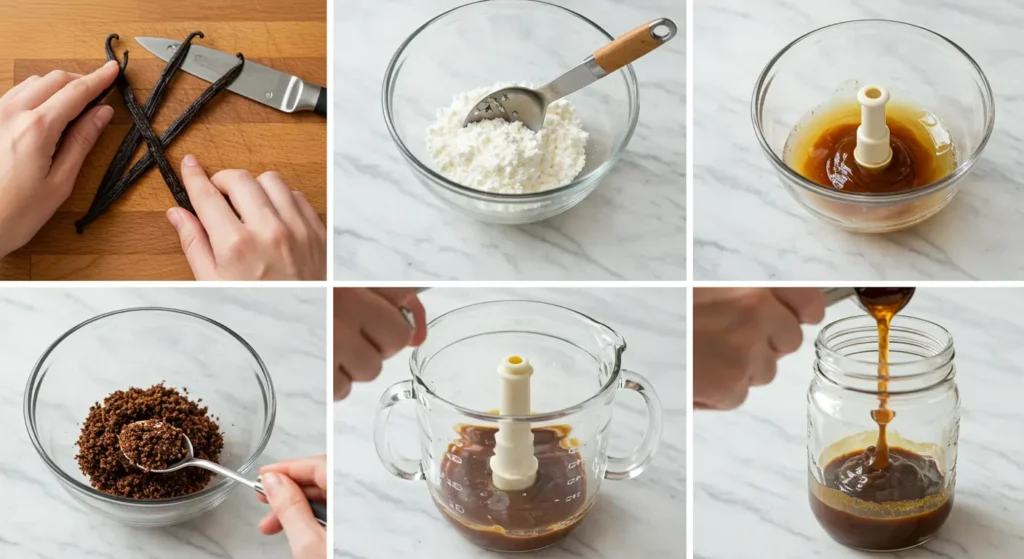
Follow this simple step-by-step guide to create the best vanilla paste recipe for 2025. Each step ensures your paste turns out smooth, aromatic, and rich in flavor.
Prepare the vanilla beans
Using a sharp knife, carefully split the vanilla beans lengthwise on a cutting board. Then, scrape out the seeds using the knife’s edge, keeping the pod for blending.
Combine the ingredients
Place the scraped seeds, pods, sugar, glycerin, and water in a mixing bowl. After that, stir gently to combine the ingredients evenly.
Blend to a smooth consistency
Move the prepared mixture into a blender or food processor. Blend on medium speed for 1-2 minutes until the paste becomes smooth and thick. Furthermore, pause occasionally to scrape the sides with a rubber spatula.
Adjust the texture
To adjust the texture, gradually add a teaspoon of water until the paste achieves the desired consistency.
Store the vanilla paste
Use a funnel (if needed) to pour the paste into an airtight jar or container. Close the jar securely and keep it in a dark, cool location for a shelf life of up to six months.
This guide ensures you craft a flavorful and versatile paste that is perfect for your baking and cooking needs!
Tips and Tricks for Perfect Vanilla Paste
Crafting the best vanilla paste recipe for 2025 requires attention to detail and a few helpful tips. These tricks will ensure your paste is rich, smooth, and long-lasting.
- Choose fresh vanilla beans: Always opt for plump, moist beans. Dry or brittle beans lack flavor and are harder to work with.
- Scrape thoroughly: Make sure to extract all the seeds from the pods. Every seed contributes to the paste’s intense flavor.
- Don’t discard the pods: Blend the leftover pods along with the seeds. They hold a significant amount of flavor.
- Use high-quality glycerin: Glycerin not only thickens the paste but also acts as a natural preservative. Thus, opt for food-grade glycerin for the best results.
- Sweeten mindfully: Adjust the sugar or sweetener to match your taste preference and intended use. For savory recipes, use less sweetener.
- Blend patiently: For a smooth texture, blend the mixture thoroughly. Stop blending occasionally to scrape the sides of the blender for an even mix.
- Experiment with flavor: Add a hint of honey, a pinch of salt, or a splash of vanilla extract to customize the taste.
- Store it properly: Use an airtight jar and keep it in a cool, dark place to maintain freshness and aroma.
These tips will help you create a flawless paste that enhances all your culinary creations!
Common Mistakes to Avoid
When making the best vanilla paste recipe for 2025, avoiding common mistakes is crucial for a successful outcome. Let’s explore common mistakes and ways to avoid them:
- Using low-quality beans: Cheap or old vanilla beans lack flavor and aroma. Therefore, always invest in fresh, plump beans for the best results.
- Skipping the pods: Many discard the pods after scraping the seeds. However, the pods hold essential oils that enhance the paste’s richness. Blend them with the seeds for maximum flavor.
- Over-sweetening: Adding too much sugar or sweetener can overpower the vanilla flavor. Start with a small amount and adjust gradually based on your preference.
- Neglecting texture adjustments: If the paste is too thick, it can be difficult to use. Add a little water at a time to achieve a smooth, spreadable consistency.
- Improper storage: Storing vanilla paste in a non-airtight container can cause it to lose its flavor and dry out. Always use a tightly sealed jar.
- Skipping blending steps: Failing to scrape the blender sides can leave chunks of unprocessed beans or pods, affecting the texture. Blend thoroughly for a smooth finish.
By avoiding these mistakes, you’ll ensure your vanilla paste is flavorful, smooth, and versatile. Keep these tips in mind for a flawless result!
Best Uses for Vanilla Paste
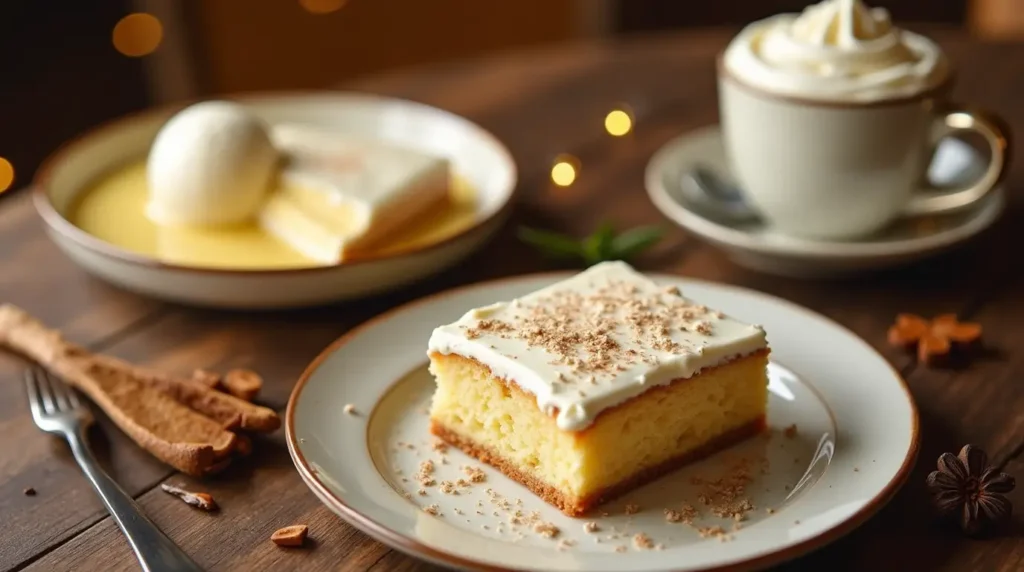
The best vanilla paste recipe for 2025 offers endless possibilities in the kitchen. The bold flavor and distinct vanilla specks make it a highly adaptable addition to countless recipes. Here are some of the top ways to use it:
- Baking: Vanilla paste enhances cakes, cookies, and muffins with a deep flavor that surpasses traditional extracts. Moreover, add it to batter or frosting for a gourmet touch.
- Custards and puddings: Use it in recipes like crème brûlée, custard, or vanilla pudding to create a creamy texture and bold taste. The specks of vanilla add a luxurious look.
- Ice cream: Stir it into your ice cream base for a rich flavor and visually appealing vanilla flecks. It’s perfect for homemade or store-bought recipes.
- Drinks: Add a small amount to coffee, tea, or smoothies for a hint of vanilla sweetness. It’s also great in milkshakes or hot chocolate.
- Savory dishes: A touch of vanilla paste can elevate sauces, glazes, or marinades, especially for seafood or poultry.
- Fruit and yogurt: Mix it into yogurt, fruit compotes, or jams to enhance their natural sweetness and aroma.
Vanilla paste is a versatile staple that brings flavor and sophistication to both sweet and savory creations.
Customizing Your Vanilla Paste
The best vanilla paste recipe for 2025 is highly adaptable, allowing you to tailor it to your preferences and culinary needs. By making small adjustments, you can create a paste that complements your favorite dishes perfectly.
- Experiment with vanilla bean varieties: Different beans bring unique flavor profiles. For example, use Madagascar beans for a creamy, rich flavor, Tahitian beans for floral notes, or Mexican beans for a bold and spicy kick.
- Add complementary flavors: Enhance the paste by including a splash of almond extract, a pinch of cinnamon, or a tiny amount of citrus zest. These additions can add complexity without overwhelming the vanilla.
- Modify the texture: If you prefer a smoother paste, strain it after blending to remove any larger pieces. For a thicker consistency, reduce the amount of water or glycerin slightly.
- Consider dietary preferences: Use alternative sweeteners like coconut sugar or stevia for a healthier version.
With these simple customizations, you can create a vanilla paste that suits your tastes and takes your recipes to the next level.
Sustainable Practices in Vanilla Production
Sustainability plays a crucial role in producing high-quality vanilla for recipes like the best vanilla paste recipe for 2025. Supporting eco-friendly methods helps protect the environment and ensures fair practices for farmers.
- Ethical sourcing: Choose vanilla beans certified as fair trade or organically grown. Such certifications guarantee fair pay for farmers and promote safe working environments.
- Supporting small-scale farms: Most vanilla comes from smallholder farms in regions like Madagascar and Tahiti. Buying directly from these farms or ethical brands promotes local economies and preserves traditional farming techniques.
- Reducing chemical use: Sustainable vanilla farming avoids harmful pesticides and fertilizers, relying on organic methods instead. This protects the soil, water, and surrounding ecosystems.
- Promoting biodiversity: Vanilla grows best when planted alongside other crops in agroforestry systems. This method maintains biodiversity and creates a healthier ecosystem for farming.
- Minimizing waste: Use every part of the vanilla bean, including the pods, in your paste. This reduces waste and maximizes flavor extraction.
By prioritizing sustainable practices, you not only enjoy better-tasting vanilla but also contribute to a healthier planet and improved livelihoods for farmers. Choosing responsibly sourced vanilla is a small step toward a more sustainable future.
Print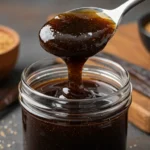
Best vanilla paste recipe for 2025
- Total Time: 15 minutes
- Yield: 1 cup
- Diet: Vegetarian
Description
This homemade vanilla paste recipe combines the bold flavor of vanilla beans with a rich, smooth texture, perfect for baking, cooking, and desserts. Simple, high-quality ingredients make it easy to create a versatile paste that adds elegance to any dish.
Ingredients
- 10–12 fresh vanilla beans (Madagascar, Tahitian, or Mexican)
- 1/2 cup granulated sugar, brown sugar, or natural sweetener (e.g., maple syrup)
- 1/4 cup vegetable glycerin
- 1/4 cup water
- 1 tablespoon honey (optional, for added flavor)
Instructions
- Prepare the Vanilla Beans: Split the vanilla beans lengthwise with a sharp knife and scrape out the seeds. Keep the pods for blending.
- Combine Ingredients: In a mixing bowl, add the vanilla seeds, pods, sugar, glycerin, and water. Stir gently to combine.
- Blend the Mixture: Transfer the mixture to a blender or food processor. Blend for 1–2 minutes until smooth and thick, scraping down the sides as needed.
- Adjust Texture: If the paste is too thick, gradually add water, one teaspoon at a time, until the desired consistency is reached.
- Store the Paste: Pour the vanilla paste into an airtight jar using a funnel, if necessary. Store in a cool, dark place for up to six months.
Notes
- For a smoother texture, strain the paste after blending to remove any larger pieces of the pod.
- Adjust the sugar or sweetener based on taste preference.
- For savory recipes, reduce the amount of sweetener.
- The pods hold significant flavor—don’t discard them!
- Prep Time: 15 minutes
- Cook Time: 0 minutes
- Category: Condiments
- Method: Blending
- Cuisine: Global
Nutrition
- Serving Size: 1 tablespoon
- Calories: 50 kcal
- Sugar: 6 g
- Sodium: 2 mg
- Fat: 0 g
- Saturated Fat: 0 g
- Unsaturated Fat: 0 g
- Trans Fat: 0 g
- Carbohydrates: 13 g
- Fiber: 0.5 g
- Protein: 0.1 g
- Cholesterol: 0 mg
Keywords: best homemade vanilla paste recipe, vanilla paste recipe, homemade vanilla paste, vanilla bean paste, baking ingredients, cooking condiments
Conclusion
Vanilla paste is a dynamic and delicious ingredient that enhances the taste of both sweet and savory creations. Crafting the best vanilla paste recipe for 2025 at home allows you to enjoy fresh, rich flavors while customizing it to your preferences. With simple ingredients, the right tools, and a clear process, creating your own vanilla paste is easy and rewarding. Remember to choose high-quality beans and follow sustainable practices to support the environment and farmers. By incorporating this homemade paste into your recipes, you’ll bring depth and elegance to every dish. Start today and enjoy the difference fresh vanilla paste makes!
If yyou like to try this Chocolate Mug Cake Recipe, don’t hesitate!
FAQ About Vanilla Paste Recipe
What are the ingredients in vanilla paste?
Vanilla paste is made with high-quality vanilla beans, sugar (or a sweetener like maple syrup), vegetable glycerin, water, and sometimes honey for added flavor. The beans provide the aromatic seeds that give the paste its bold flavor.
Why use vanilla paste instead of vanilla extract?
Vanilla paste offers a richer, more intense flavor with visible vanilla seeds, enhancing the visual appeal of your dishes. It’s thicker than extract, making it perfect for recipes where texture and appearance matter.
How long will vanilla paste last?
When stored in an airtight container in a cool, dark place, vanilla paste can last up to six months, maintaining its rich flavor and aroma throughout.
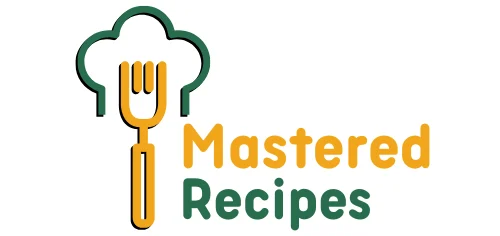
1 thought on “Best Vanilla Paste Recipe for 2025: Step-by-Step Guide”